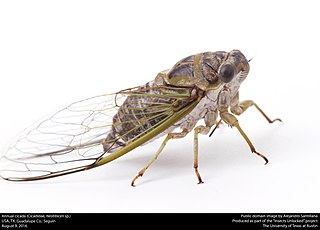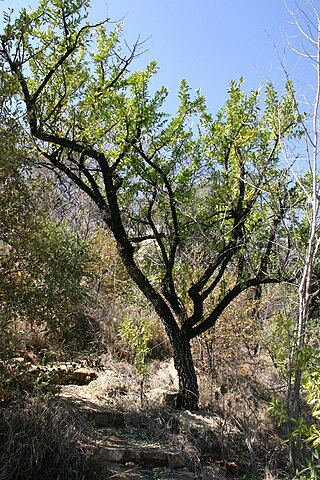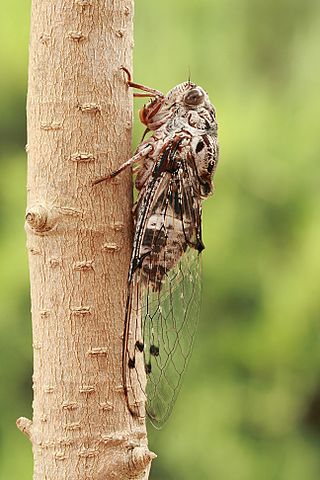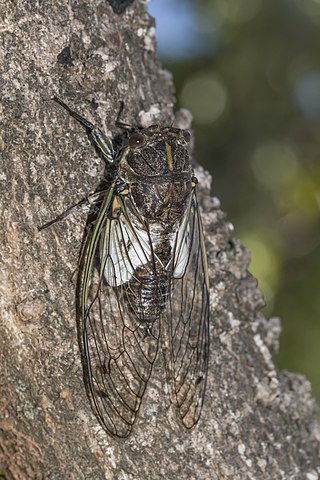
The cicadas are a superfamily, the Cicadoidea, of insects in the order Hemiptera. They are in the suborder Auchenorrhyncha, along with smaller jumping bugs such as leafhoppers and froghoppers. The superfamily is divided into two families, the Tettigarctidae, with two species in Australia, and the Cicadidae, with more than 3,000 species described from around the world; many species remain undescribed. Nearly all of cicada species are annual cicadas with the exception of the few North American periodical cicada species, genus Magicicada, which in a given region emerge en masse every 13 or 17 years.

Cicadidae, the true cicadas, is one of two families of cicadas, containing almost all living cicada species with more than 3,200 species worldwide.
In biology, exuviae are the remains of an exoskeleton and related structures that are left after ecdysozoans have molted. The exuviae of an animal can be important to biologists as they can often be used to identify the species of the animal and even its sex.

The Kwazulu-Cape coastal forest mosaic is a subtropical moist broadleaf forest ecoregion of South Africa. It covers an area of 17,800 square kilometers (6,900 sq mi) in South Africa's Eastern Cape and KwaZulu-Natal provinces.

The red-capped robin-chat or Natal robin is a species of passerine bird belonging to the family Muscicapidae. This species is found in Southern and Eastern Africa.

The African broadbill, also known as the black-capped broadbill or Delacour's broadbill, is a species of bird in the sub-oscine family Calyptomenidae.

The chorus cicada, Amphipsalta zelandica, is the most common species of cicada in New Zealand, where it is endemic and found in most areas. They typically live in forests and areas with open bush, where their left-over nymph skins can be seen on tree trunks and branches during the summer months. The males produce their cicada sound in unison, which can reach deafening proportions at the height of their population around February. Groups of cicada can suddenly transition from the typical cicada sound to synchronised clicks, using their wings to clap against the surface they are sitting on.

Platypleura divisa is an African cicada first described by Ernst Friedrich Germar, entomologist and professor of mineralogy at Halle, who also studied beetles.

Platypleura is a genus of cicadas that occurs widely across Africa and southern Asia. Some of the South African species are remarkable for their endothermic thermoregulation that enables crepuscular signalling, an adaptation that reduces risk of predation and enables a greater range for their calls. In field experiments their maximum body temperature while calling at dusk, was measured at 22 °C above ambient temperature.

Gymnosporia heterophylla, the common spike-thorn, is a small, hardy, deciduous African tree up to 5m tall, occurring in rocky places with a wide distribution from Ethiopia, the Sudan and the Congo, south to the Cape Province and west to Angola and Namibia, as well as the neighbouring islands of Madagascar and Saint Helena, with a closely related species from Mauritius.

Cyclochila australasiae is a species of cicada and one of Australia's most familiar insects. It is distributed through coastal regions of southeastern Australia. Green specimens are commonly known as green grocers and yellow ones as yellow mondays.

Aleeta is a genus of cicadas with the only species Aleeta curvicosta, one of Australia's most familiar insects. Native to the continent's eastern coastline, it was described in 1834 by Ernst Friedrich Germar.

Psaltoda plaga is a species of cicada native to eastern Australia, from Maryborough in central Queensland to Bega in southern New South Wales. Adult cicadas appear over the summer and inhabit forested areas near bodies of water. The predominantly black form from the Sydney and Central Coast regions is commonly known as the black prince, while the term silver knight is used for the species as a whole.

Psaltoda is a genus of cicada found in eastern Australia. Originally described by Carl Stål, the type species is Psaltoda moerens known as the redeye, and P. plaga is a well-known species from eastern Australia, known as the black prince. Fifteen species are recognised. Relationships of the species with each other remains unclear.

Brevisana brevis, known as the shrill thorntree cicada, is a cicada found in Africa and is the loudest insect on record. It has been recorded producing sounds with pressure levels of 106.7 decibels at a distance of 50 cm.

Arunta perulata is a large cicada native to Australia. It is also known as the white drummer cicada. The name floury baker was previously applied to this species, but that name is now specific to Aleeta curvicosta.

Pycna is a genus of cicadas from Africa and Asia.

Platypleura haglundi is a medium-sized African cicada species, that occurs from northern South Africa to Zimbabwe, where it is found in diverse habitats. In South Africa it has been recorded in North West, the northern Free State, Northern Province, Gauteng, Mpumalanga and Kwazulu-Natal. The type was collected in Weenen Game Reserve, KwaZulu-Natal.

Ioba leopardina is an African species of Cicada. They are 4–5 cm (1.6–2.0 in) long, including the wings, and with mottled grey cryptic colouration.

Stagira is a genus of cicadas in the family Cicadidae. There are at least 30 described species in Stagira.




















